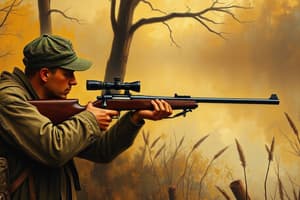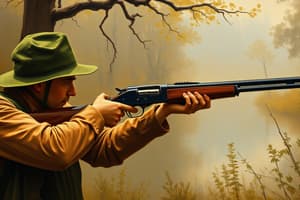Podcast
Questions and Answers
What are the Four Primary Rules of Firearm Safety?
What are the Four Primary Rules of Firearm Safety?
- Be sure of the target and what is in front of and behind it. (correct)
- Keep your finger outside of the trigger guard until you are ready to shoot. (correct)
- Treat every firearm with the respect due a loaded gun. (correct)
- Watch the muzzle. (correct)
Which of the following is NOT one of the 6 additional rules about firearm safety?
Which of the following is NOT one of the 6 additional rules about firearm safety?
- Point a firearm only at something you intend to shoot
- Ignore the weather conditions while shooting (correct)
- Unload firearms when not in use
- Check your barrel and ammunition
What is the purpose of hunter education?
What is the purpose of hunter education?
To ensure the continuation of the hunting tradition.
What does the Pittman-Robertson Act provide?
What does the Pittman-Robertson Act provide?
What is a firearm?
What is a firearm?
What is the function of the action in a firearm?
What is the function of the action in a firearm?
What is the role of the stock in a firearm?
What is the role of the stock in a firearm?
What is the barrel of a firearm?
What is the barrel of a firearm?
What is a bolt-action rifle's firing pin?
What is a bolt-action rifle's firing pin?
What is a shotgun slug?
What is a shotgun slug?
How do you operate a pump action firearm?
How do you operate a pump action firearm?
What describes good marksmanship?
What describes good marksmanship?
What is a misfire?
What is a misfire?
What does the term 'choke' refer to in shotguns?
What does the term 'choke' refer to in shotguns?
Flashcards are hidden until you start studying
Study Notes
Firearm Safety Rules
- Four primary rules: Watch the muzzle, treat every firearm as if it's loaded, know your target and what's beyond it, keep fingers off the trigger until ready to shoot.
- Six additional safety rules: Check barrel and ammo, unload firearms when not in use, point only at intended targets, avoid running or climbing with loaded guns, store firearms and ammo separately, avoid alcohol before/during shooting.
Purpose of Hunter Education
- Ensures the continuation of hunting traditions while promoting safety and responsible practices.
Pittman-Robertson Act
- Federal Aid in Wildlife Restoration Act that funds wildlife habitat selection, restoration, improvement, and wildlife management research and education.
Firearm Components
- Firearm: Mechanical device using pressure from burning powder to fire a projectile through a tube.
- Action: Moving parts of a firearm that load, fire, and eject cartridges.
- Stock: The handle of the firearm, usually made of wood or synthetic material.
- Barrel: Metal tube where the projectile travels; varies for rifles, handguns, and shotguns.
Bolt-Action Rifle Features
- Firing pin: Strikes the primer to ignite the cartridge.
- Bore: Inside of the barrel where projectiles travel.
- Breech: Rear end of the barrel.
- Receiver: Metal housing for action components.
Shotgun and Handgun Components
- Magazine: Holds ammunition before loading into the chamber.
- Wad: Seal/container in shotshell separating powder from shot.
- Cylinders, hammer, ejector rod in handguns: Essential for ammunition storage and ignition.
Ammunition Types
- Cartridge: Modern rifle ammunition including primer, gunpowder, and bullet.
- Shotshell: Used in shotguns; contains primer, gunpowder, wad, and slug or shot.
- Centerfire vs. Rimfire: Centerfire has a primer in the casing base, while rimfire has primer in the rim; Centerfire is reloadable.
Shot Sizes and Applications
- Smaller shot number correlates to larger pellet diameter; used in various hunting applications depending on game type.
- Magnum shells contain more shot or gunpowder than standard shells.
Shotgun Chokes and Patterns
- Choke: Degree of narrowing at the shotgun's muzzle; affects spread of the shot.
- Full choke: Tight constriction suitable for long-range shooting; improves patterns at over 40 yards.
Marksmanship and Shooting Techniques
- Good marksmanship fundamentals: Practice, proper techniques, and sight adjustment.
- Accurate shot range for deer: 8 inches.
- Positions for shooting: Prone is the steadiest, followed by sitting, kneeling, and standing.
Sight Options and Adjustments
- Open sight: Simple bead/post front with notched rear.
- Telescopic sights: Scopes for enhanced targeting.
- Collimator: Tool for sight adjustment in rifles.
Operational Techniques for Firearms
- Bolt-action operation: Lift the handle, pull back to eject shells.
- Lever-action: Push lever down and forward to extract shell.
- Pump-action: Slide fore stock backward to load the next cartridge.
Behavioral Strategies: Hunting Methods
- Still hunting: Stealthily staying still to wait for game.
- Stalking: Following animal signs for a closer approach.
- Use of ground blinds: Setting up downwind, away from the sun, with safe backgrounds for effective concealment.
Driver and Poster Technique
- Drivers push animals from wooded areas while posters wait to intercept them; a strategic method used in hunting.
Studying That Suits You
Use AI to generate personalized quizzes and flashcards to suit your learning preferences.




